
 |
||
| Talisman Magick | ||
| Tarot Spells |
| Knowing
your astrological trends compares to a road map in an otherwise unknown
city. It gives you the direction you need to achieve assured success! |
| Click
here and see how a Chi Generator can help you in your work toward cosmic
consciousness! The Welz Chi Generator is the ideal tool to boost the power of any spiritual work that you perform. This extraordinary technology provides you with a continuous supply of life force in any practice that has the goal of positive permanent change and self-improvement, such as visualization techniques, motivational work, treasure mapping, trend management, hypnosis, neuro-linguistic programming, shamanic practices or any other kind of magical-religious practices. Life force is the motor of any action at a distance. The transfer test in our web sites will give you irrefutable proof of this fact. The ATGS 3000 Astro Trend Generating System is especially suited for the astrologer who intends to go much beyond mere consulting of his clients by actively managing their trends based on astrological guidelines, thus ensuring energetic assistance that can be effortlessly effective and successful! Like all other devices from HSCTI, the ATGS 3000 is backed by our life time customer support. |
| Introduction | Lesson I | Lesson II | Lesson III | Lesson IV | Lesson V | Lesson VI | Lesson VII |
Astrology for Magicians and Metaphysicists - IntroductionIn the following lessons you will find an introduction to natal astrology. I am using the key-word method, because I realized that this is the most efficient way to gain the skills of natal chart interpretation. Conversely, you may use the same method to set up your astro trend generation units for the purpose of taking control of your stars!How to Draw and Evaluate an Astrological ChartThe astrological chart is a representation of the astrological factors at the time of the event it describes. In the case of a birth chart, it represents the positions of the planets and houses as seen from the place of birth at the time of birth.The following is not designed to give you an understanding of the astronomical factors involved. I will rather give you a step by step introduction that helps you understand the structure of a chart, to design it and to understand it. You need not know the astronomical basis of astrology for this task. I am going to use the method that shows the planets as they are in the zodiac (European method) rather than the twelve-equal-wedges method that is still practiced in the Anglo Saxon countries. This latter method shows the astrological signs and planets in the houses. With this antiquated method it is rather difficult to see and evaluate midpoints and structural patterns of aspects, both of which are important for our task to generate astrological trends. If you have a computer program that calculates your charts, be sure to have a printout that shows the planets and houses in the zodiac -- the way you are going to learn in the following pages. It is the ZODIAC in which you will draw all the
planets, house cusps, and other factors of the chart. This zodiac is
represented by a circle of 360 degrees. The degrees are counted in a
counter-clockwise manner.
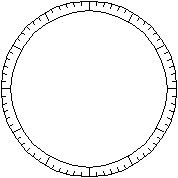
The zodiac is subdivided into twelve equal parts of 30 degrees each. These twelve equal parts are the astrological signs. The beginning of the zodiac is set at the point that the sun occupies at the exact time of the spring equinox. This point is 0 degrees of the sign of Aries. You find this point at the right side of the chart. From there the 30 degrees of Aries are counted in a counter clockwise manner until 30 degrees Aries which is 0 degrees Taurus. For your convenience, each sign is subdivided into
six sections of five degrees each. As you proceed in magical astrology,
you will find out that this subdivision has a very special meaning.
The circle below shows the twelve signs of the zodiac.
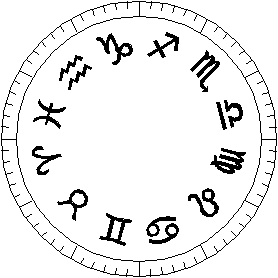
The zodiac is always here. Everything else moves through the signs of the zodiac at its own speed. The Sun completes one orbit through the zodiac in one year, the Moon in 28 days, Jupiter 12 years, etc. The system of the houses makes one rotation through the zodiac every twenty-four hours. This movement is caused by the rotation of the Earth around its axis. Rulers of the signsEach sign is affiliated with one or two planets whose action, or function, best corresponds to the energy of the sign. Traditionally these planets were called the "rulers" of the sign. The following diagram shows you the rulers of each sign. The outside circle shows the day-rulers, the central circle shows the night-rulers, the inner circle shows the signs.
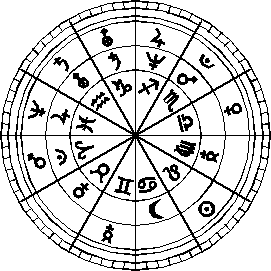
Elements (Triplicities) and QuadruplicitiesYou learned about quadruplicities in the course material. The chart below shows you the distribution of elements and quadruplicities.

Inscribing the housesThe first thing we do is draw the cusps of the twelve houses into the circle of the zodiac. We work with a chart for September 14, 1974, at 1:33 p.m. daylight savings time in New York.The twelve houses are twelve sections that are distributed in the zodiac in a counter clockwise manner. Unlike the signs of the zodiac, the houses are not of equal size. The cusp (= beginning) of the first house, or ascendant, is at 13 Sagittarius and 12 minutes of arc, or 13:12 degrees of Sagittarius. This, then, was the point of the zodiac that was rising in the East at that time. The beginning of the tenth house is at 2 degrees Libra and 46 minutes of arc, or 2:46 degrees of Libra. The beginning of the tenth house is called Midheaven. This is so because the midheaven is the point of the zodiac that is "in the middle of the sky." It is at the point where the sun is at Noon. The cusp of the seventh house, or descendant, is the point in the zodiac that is exactly opposite the ascendant. It is 13 degrees Gemini and 12 minutes of arc, or 12:13 degrees Gemini. The cusp of the fourth house is on the opposite
side of the tenth house cusp, in 2:46 degrees of Aries.
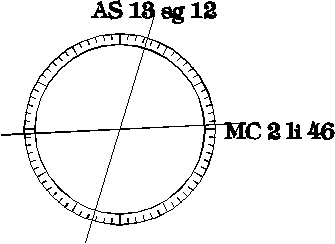
We proceed to draw all other house cusps into the chart. With the houses drawn into the chart, you see that the houses are not equal. The first house measures from 13:12 Degrees of Sagittarius to 17:22 degrees of Capricorn. It is slightly larger than 30 degrees, while the eleventh house measures from 1:11 degrees of Scorpion to 23:39 degrees of the same sign, hence it is much smaller than 30 degrees. The axis from the first to the seventh houses marks the horizon. The axis from the tenth to the fourth houses marks the extension of the meridian. The houses from one through six are always below the horizon. The houses from seven through twelve are always above the horizon, visible from the place of the event. The houses are always in the same sequence, from 1 through 12. I prefer to write the house numbers in Roman numerals. I do this so that they will not be confused with numbers that mark the position in degrees. The ascendant, or the point of the zodiac that rises in the East at the time of birth (or at the time of an event) is by far the most influential part in a chart. It exceeds even the sun in importance. In pop-astrology, the person who was born at the time for which the sample chart was erected, would be considered a Virgo, because this person has the sun in Virgo. However, considering the importance of the rising degree, I would say that this person is a Sagittarian with the sun in Virgo. Inscribing the PlanetsThe next step is inscribing the planets into the chart. Here we proceed in the same fashion as we did when we inscribed the twelve houses: The sun is marked into 21 degrees of Virgo 31 minutes of arc (roughly 21 1/2 degrees on the chart), the Moon is 2:08 Virgo (the mark is close to the two degree line), etc.
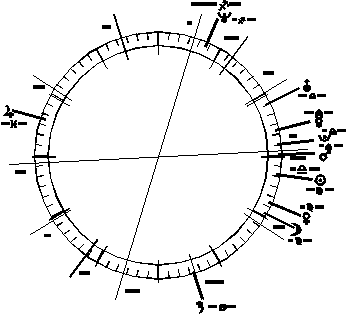
Inscribing the AspectsOur next step is to find the aspects between the planets and inscribe them into the chart. Here you will already see the advantage of the chart pattern that you learn to use: With a bit of practice, you can directly read the aspects from the chart.As you have read in the course, an aspect between two planets exists if the planets are within the range of specific angles from each other. For the beginning, we consider only the major aspects: The opposition, or 180 degrees apart (opposing), the trine, or 120 degrees apart, the square, or 90 degrees apart, the sextile, or 60 degrees apart, and the conjunction, where the planets are close to each other. An exact aspect is very brief. This is so because the planets are always in motion. However, an aspect is valid within a certain range of accuracy. This range is called "the maximal orb" of an aspect. Consequently, an opposition is valid when the planets are between 172 and 180 degrees apart. This means that the maximal orb for an opposition is 8 degrees. The same holds for a conjunction that is good up to a distance of 8 degrees. The square has an orb of 7 degrees, the trine 7 degrees, and the sextile 6 degrees. The effect of an aspect is strongest when it is exact. It is weakest when it reaches the orb. For instance, two planets exactly 60 degrees apart are in their strongest mutual aspect, while when 54 or 66 degrees apart, the influence of the aspect is still noticeable, but it is very weak. We inscribe the aspects as lines that connect the planets in aspect. Draw blue lines for soft aspects (trine and sextile) and red lines for hard aspects (squares and oppositions). In our sample chart we used two different dotted lines. Abbreviations and SymbolsYou are familiar with the symbols for planets, signs and aspects. In the following I will show you a system of abbreviations that allows you to enter the signs, planets, houses, etc., easily into any computer, or write it with any typewriter or word processor. These abbreviations are also an excellent tool for another purpose: You can use them to write astrological "formulas" that you can then translate into statements using the key word method that you have been taught in this course.
Aspects: write the degrees for the exact aspect: 60 for sextile, 90 for square, 00 for conjunction, 180 for opposition, etc. Examples for AbbreviationJupiter in Leo -- J leJupiter in Leo in the Third House -- J le 3 Jupiter in Leo in the Third House Sextile Mars in Gemini in the First House -- J le 3 60 A gm 1 etc. Click here for Lesson I - Back to Astrology PageMagitech Home Page (orgone technology and more free courses) |